Where did it all go wrong for the United States? After crashing out at the group stage of the Copa America, we pick through the bones of their desperately poor campaign. It wasn’t all about a red card and poor officiating.
It was 19 months and three days ago that the United States men’s national team progressed through the group stage of the 2022 World Cup without a defeat. A win and two draws came from an unremarkable two goals scored and one conceded, but there was a feeling of aptitude in those performances against Wales, England and Iran.
That positivity was nicely balanced with a Didier Deschamps-like cynical realism of doing what was necessary to advance through a middling group at a major tournament while showing signs of an on-pitch product that made sense.
That product was built on the foundation of a respectable Tyler Adams-Weston McKennie-Yunus Musah midfield, disruptive wing-backs in Sergiño Dest and Antonee Robinson, and a Christian Pulisic-led attack producing football at a level of fluidity U.S. fans and the neutral global football community could both appreciate.
It felt reasonable to be enthusiastic about that product, even after another World Cup run ended in the last 16.
But that was 19 months ago. We now know that moment for what it was: fleeting, not foundational for a future in which the bar had been raised for U.S. soccer, even for a generation.
A year and a half is plenty of time to appraise progress or determine something has stagnated or degenerated. After leaving their own party early following group-stage disappointment at the Copa America, the future, as it so often is, has arrived in underwhelming fashion with its components exposed as ordinary rather than refined.
There were warning signs and hard realities that pointed to the possibility of this team not being what U.S. fans hoped. There was the Dest injury. Least subtly, there was the 5-1 defeat to Colombia on 8 June. There was the fact that Adams hasn’t played much football since the World Cup because of his own persistent injuries. There was the inclusion of Giovanni Reyna in the starting XI, which felt unnecessary and destabilising even if it was excusable given the quality of the opponent in their opening match.
Once play started, there were strikingly stale stretches early against a Bolivia side that may have been the worst in the tournament that were papered over by two first-half goals. That was bookended by a 1-0 defeat to Uruguay on Monday night in which the United States failed to create a substantial scoring opportunity in a must-win match among a group from which they had a pre-tournament probability of 64.5% to progress.
Gregg Berhalter will lose his job over the Copa America exit, and that seems reasonable because the list of excuses – either stated or implied – are the natural order of a coach without the vision or problem-solving capacity a person in his position should possess.
That started before the tournament. Berhalter’s answer to losing Dest, a dynamic right-footed attacking wing-back, to injury was a more traditional approach on the right side with Joe Scally playing right-back. Options were limited because this is international football and options are always limited when a key player goes down for teams not named France.
Faced with such a problem, a national team can adapt their remaining personnel to attempt to reproduce a system that’s shown promise, or they can introduce personnel that will alter that system.
In choosing Scally at right-back, Berhalter ostensibly chose the latter option, which is hardly punishable by death. But in choosing, on top of that, to disrupt the midfield by starting Reyna over Musah, Berhalter abandoned continuity in both the system and the personnel in a significant way.
What he was left with was a right-sided attack that became a comparative afterthought following a World Cup in which balance was not only evident, but productive.
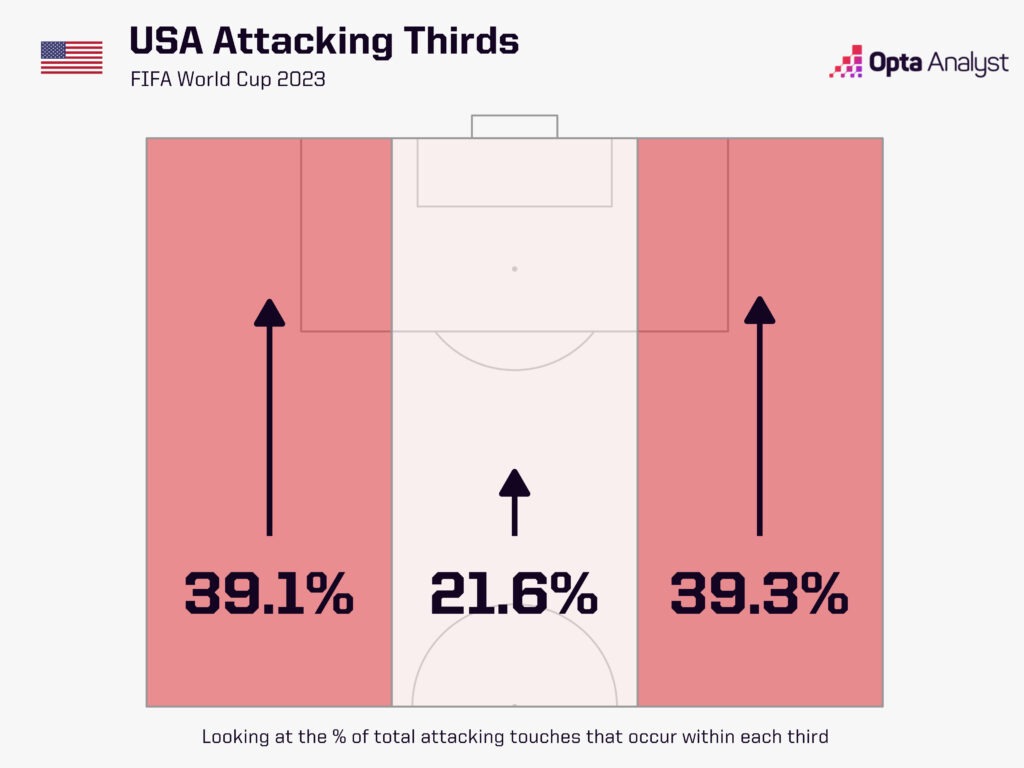
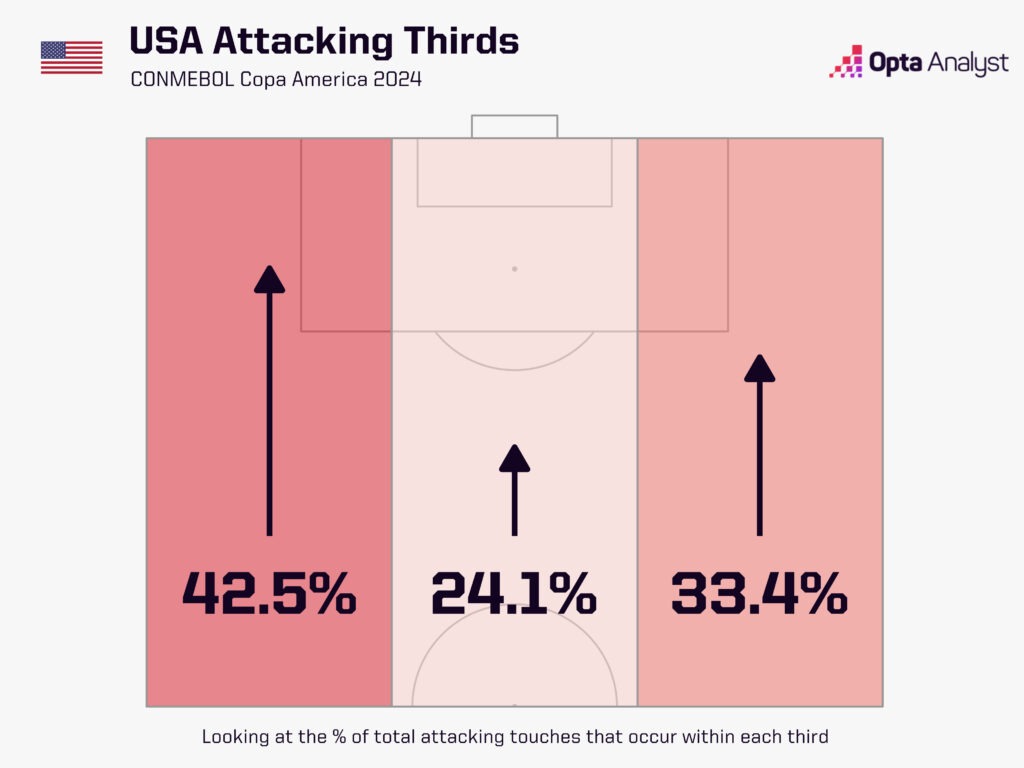
The United States’ three goals at the Copa America all came from the left, which alone is hardly an indictment of what was going on across the pitch. The above graphic breaks down only the United States’ touches. If we introduce a possession share consideration into it with zones labelled as U.S.-controlled, opposition-controlled and contested, we’ll see below how Berhalter’s side dictated or failed to dictate play in each competition.
The U.S. controlled play up the right side during the World Cup in the attacking third without a zone on the entire side controlled by the opposition:
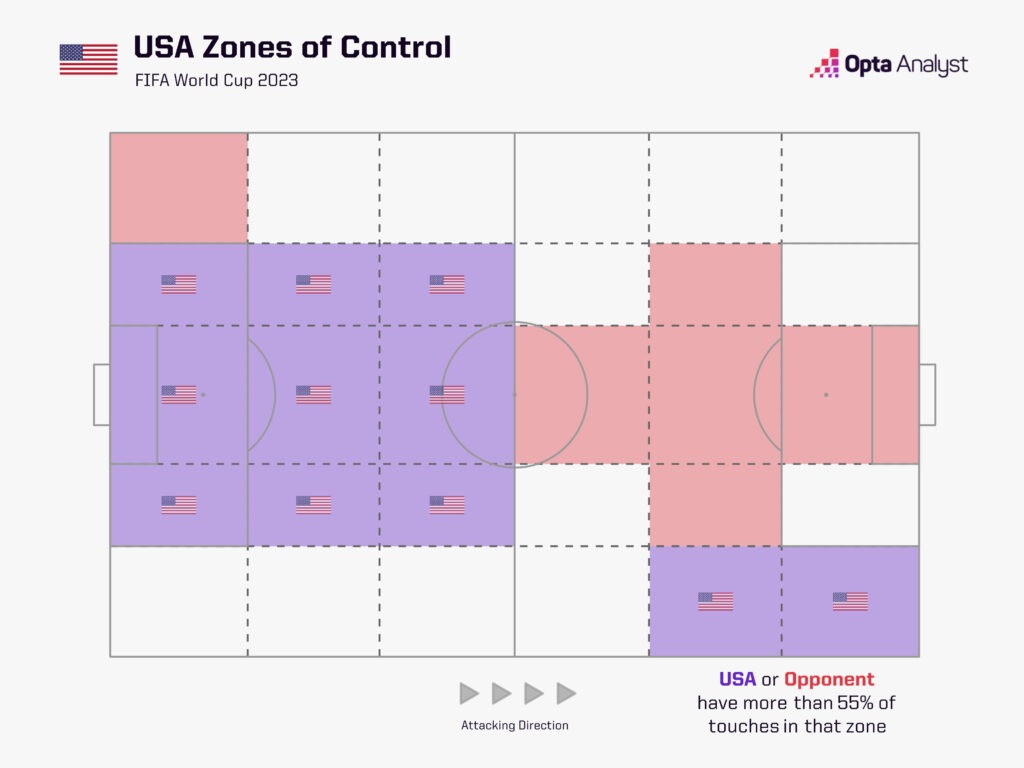
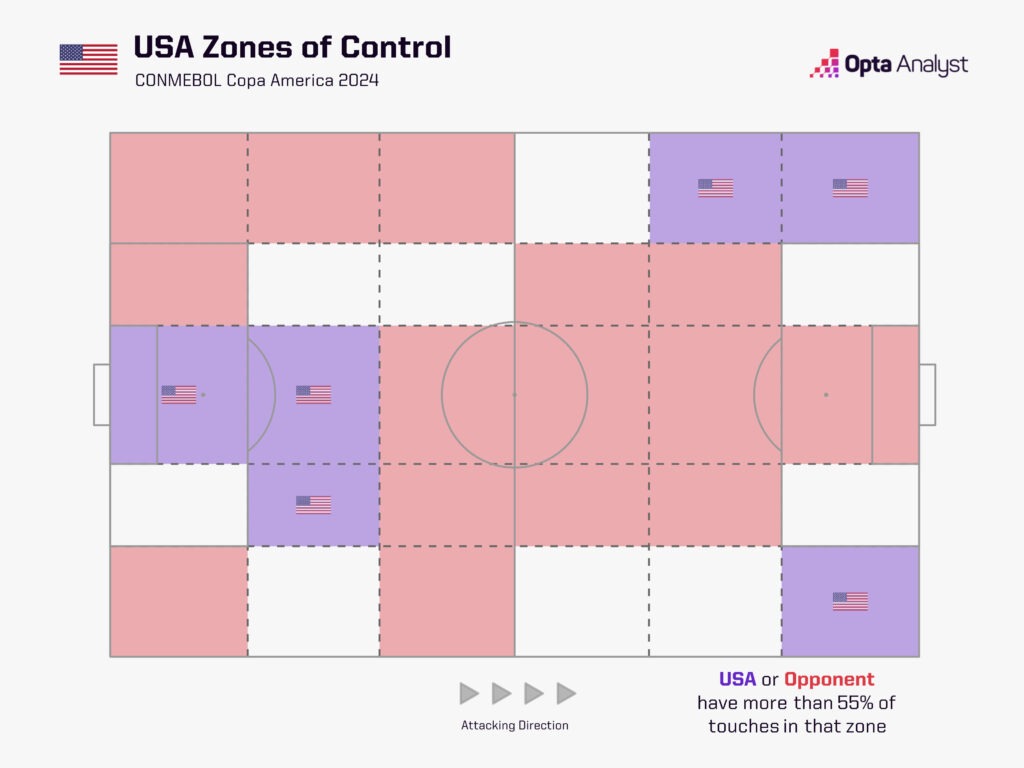
There was less of that in the Copa America with one of the zones on the right wing changing from a U.S. area of control to a contested area of the pitch and two of the contested areas (white) of that right side becoming controlled by their opponents (red). That’s hardly surprising and may even seem minimal, and it may have been on its own.
If we switch our focus from the right side to the middle of the pitch, it becomes evident where things really went wrong for the U.S.
In their own half during the World Cup, the U.S. owned the entire middle of the pitch. That deteriorated in the Copa America with certain zones turning contested and some taken over by the opposition. The same shift happened in the attacking half with their Copa America opponents controlling play.
Possession is one thing, stringing together functional sequences of play that lead to shots is another.
Both U.S. full-backs contributed to the latter in the World Cup, and not only in the build up. Dest created three chances in the group stage. Robinson had three as well. Note there’s also a healthy creative footprint from the midfield in the opening three matches:
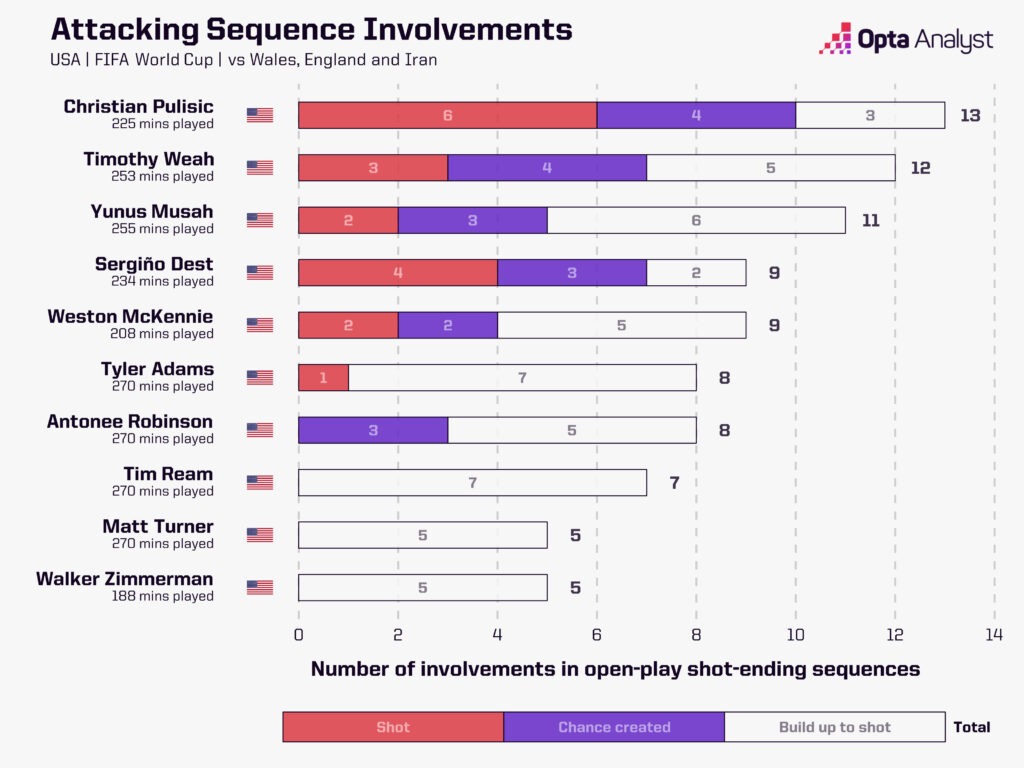
Consistency fell off on the right at the Copa America, with Scally creating one chance. That’s not Scally’s fault – he didn’t claim to be or try to be Dest – and it might not even be Berhalter’s fault given the tough spot the Dest injury put him in.
What seems less forgivable for Berhalter is the subsequent midfield production, particularly the attacking sequence involvements of two of his starting midfielders.
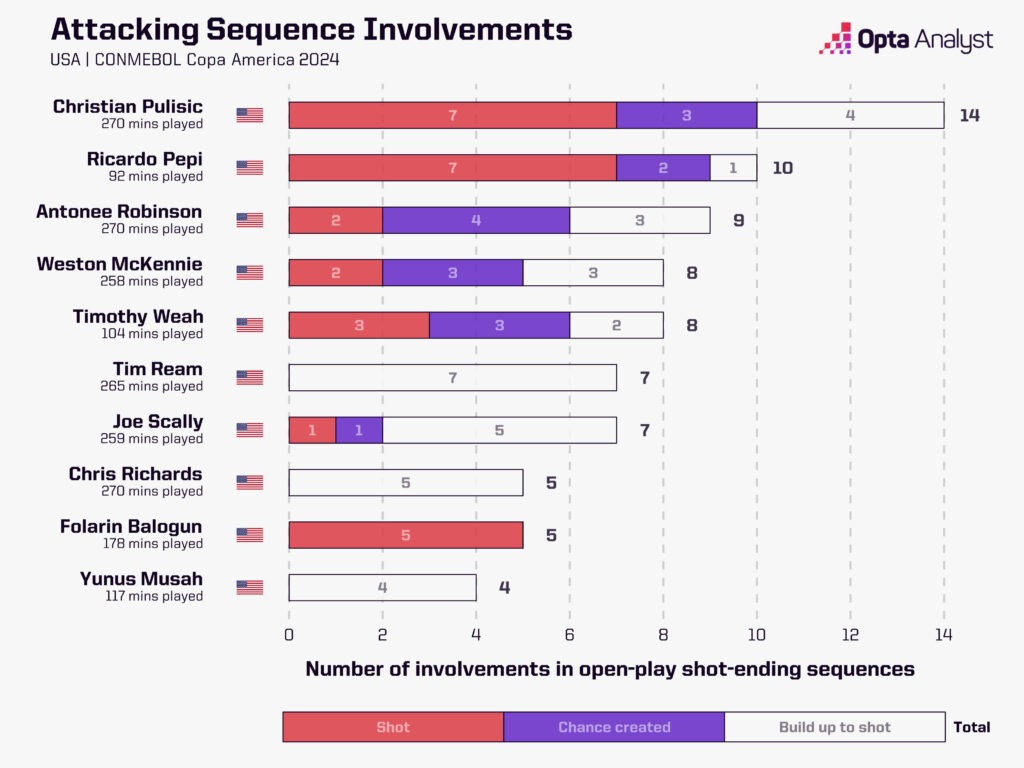
The names Tyler Adams and Gio Reyna simply aren’t there. That’s because they were a part of only three such sequences each. They combined for two chances created in 381 minutes.
Reyna was involved in three open-play shot-ending sequences in 201 minutes, and Adams three in 180. Particularly for Reyna given the differences in their responsibilities, that amounts to absenteeism.
To be fair to Reyna, it wasn’t any better when Musah came into the starting XI. Against Uruguay, Adams completed one combined pass to Musah and McKennie (Adams to Musah). McKennie completed one combined pass to Adams and Musah (McKennie to Adams). Musah completed one combined pass to McKennie and Adams (Musah to McKennie).
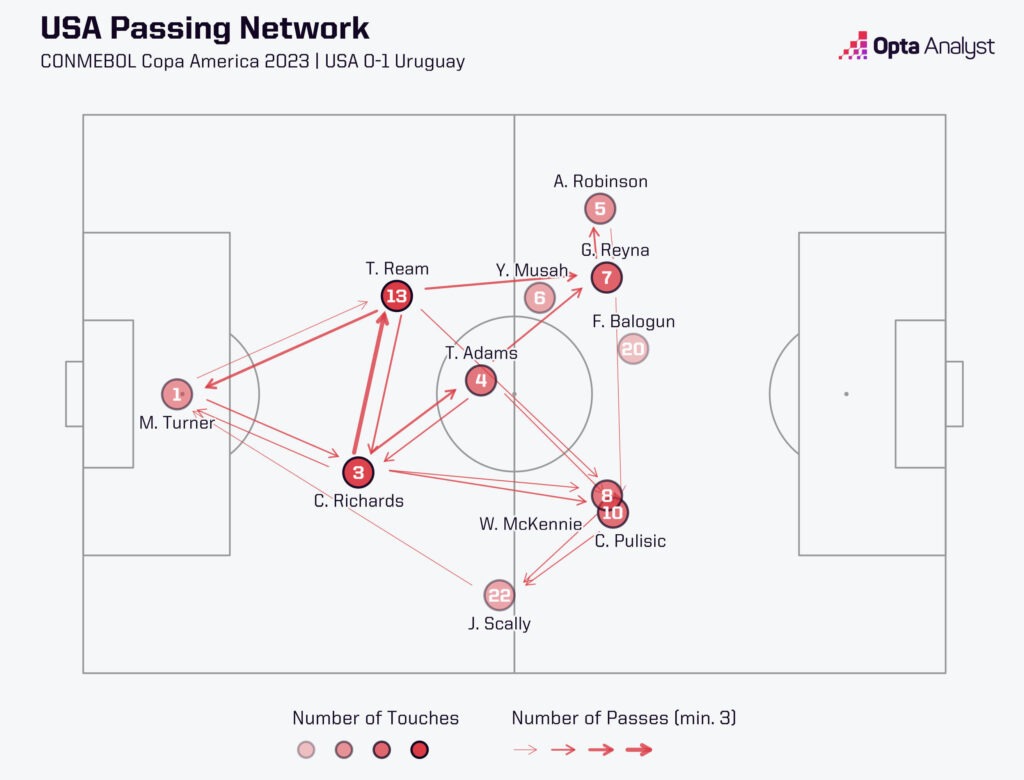
To clarify, those three passes were not a sequence that took place during one move. Those three passes are their matrix for the entire match. Adams and McKennie played the entire match. Musah came off in the 72nd minute. That seems almost impossible, regardless of how disjointed the match was or how infrequently the ball was actually in play.
Uruguay played a 4-2-3-1, but if you invert the U.S. triangle to a double pivot of Federico Valverde and Manuel Ugarte supporting Nicolás de la Cruz, that trio combined for 19. That’s hardly Iniesta-Xavi-Busquets, but it’s not three.
The midfield was a shell of what it had been at the World Cup. It’s difficult to say whether that was because Berhalter didn’t allow the Adams-McKennie-Musah midfield to play together until the final match – and even then without an attacking right-back – or because the players just aren’t as effective as they were 19 months ago. What’s more certain is the decisions that were made did not work, and there should probably be a change in how things are done from a coaching perspective and how this team is regarded from a player perspective.
The phrase ‘golden generation’ has been thrown around for a few years now. It’s at this stage an irresponsible and misleading label applied by overzealous media because they finally see a U.S. squad comprised of players at respectable European clubs.
There’s nothing golden, bronze or pewter about a team that just connected on 75.6% of their passes over the course of 270 minutes against Bolivia, Panama and Uruguay.
During the World Cup, that tournament-long passing accuracy stood at 84.5% after their last-16 exit against the Netherlands, and their passing accuracy ending in the final third was 72.6%. Both of those were among the top 10 at the 32-team event. Their final-third passing accuracy at the Copa America was 60.7% – worse than Jamaica.
The numerical evidence of how disjointed things became is significant, and while a first-half red card in their second match will disrupt tournament-long numbers to an extent, there’s plenty to consider outside of the 2-1 defeat to Panama.
Remarkably, Matt Turner attempted more passes than each of his midfield or attacking teammates in the loss to Uruguay. He attempted more passes than Reyna and McKennie – two of Berhalter’s starting midfielders – during the tournament. Turner, it’s worth making abundantly clear, is the U.S. goalkeeper.
Pulisic ended the Uruguay match by losing possession as many times as he attempted a pass (25 each). Across the tournament, he had fewer successful passes (58) than possessions lost (59). Among players with at least 50 successful passes at the tournament heading into the knockout stages, only Pulisic and Alexis Sánchez lost possession more frequently than they completed a pass. Sánchez completed 55 passes and lost possession 63 times.
That may be oversimplifying the output of the United States’ most exciting player who started the tournament with a goal and an assist against Bolivia. For the sake of comparison, Vinícius Júnior is close to falling into that classification (43 successful passes, 49 possessions lost), but the tradeoff is efficacy. Vini Jr. is having an average tournament, but he’s still created an open-play chance for every 9.8 possessions lost. For Pulisic, it was a chance from every 19.7.
McKennie was absent for long stretches of the tournament, attempting just 24.1 passes per 90 at a 75.4% success rate after attempting nearly twice as many (46.5) per 90 at the World Cup with slightly more success (77.5%).
Reyna attempted as many shots as Malik Tillman – one.
Adams had three combined interceptions and tackles won after collecting 13 at the World Cup.
And then there’s Timothy Weah. He leaves this tournament as the villain for his red card against Panama, but he entered it as a Serie A-seasoned, right-footed, attack-minded player who spends a decent amount of time as a wing-back. How much of a consideration was starting Weah at right-back for Berhalter? If it had been, there’s a starting XI in which Berhalter could have retained the Adams-McKennie-Musah midfield that worked at the World Cup while also preserving the attacking ethos of the right-back position.
By moving Weah, Berhalter would have been freeing up minutes farther up the pitch for Reyna to be himself creatively rather than needing to attempt to fit into a less suitable two-way role in a midfield three. It, again, would have been an attempt to retain the balanced 4-3-3 system that worked at the World Cup. It never happened.
Excuses are abundant. Host nations to crash out of the Copa America after the group stage are not. The United States are the first. The World Cup is 23 months away. At some point a new U.S. coach will express that the expectation is that it won’t happen again. And that’s as golden as it can be right now.
Enjoy this? Subscribe to our football newsletter to receive exclusive weekly content. You should also follow our social accounts over on X, Instagram, TikTok and Facebook.
